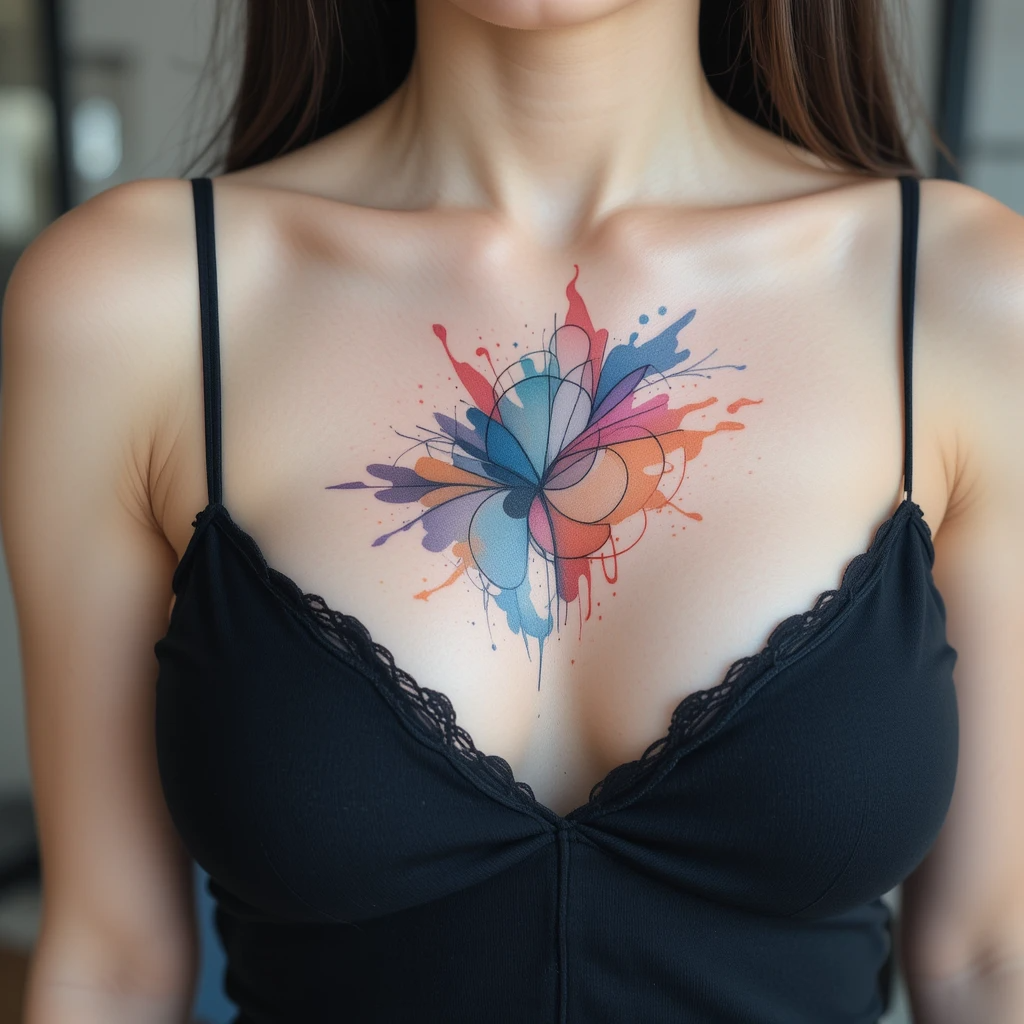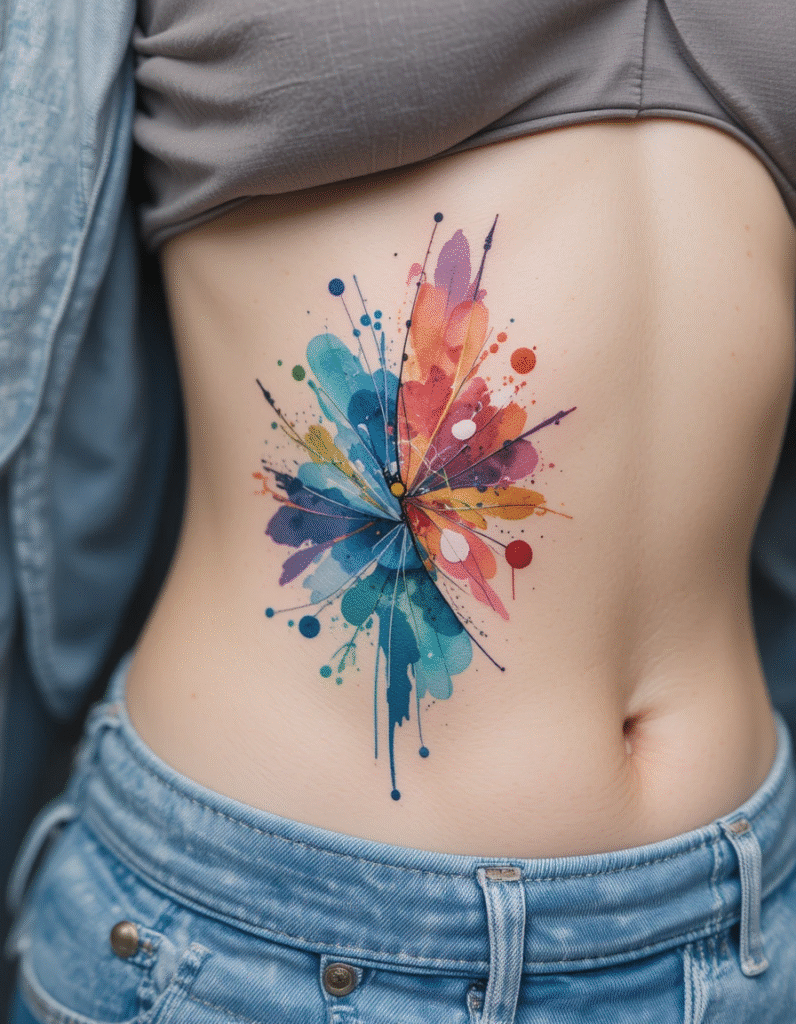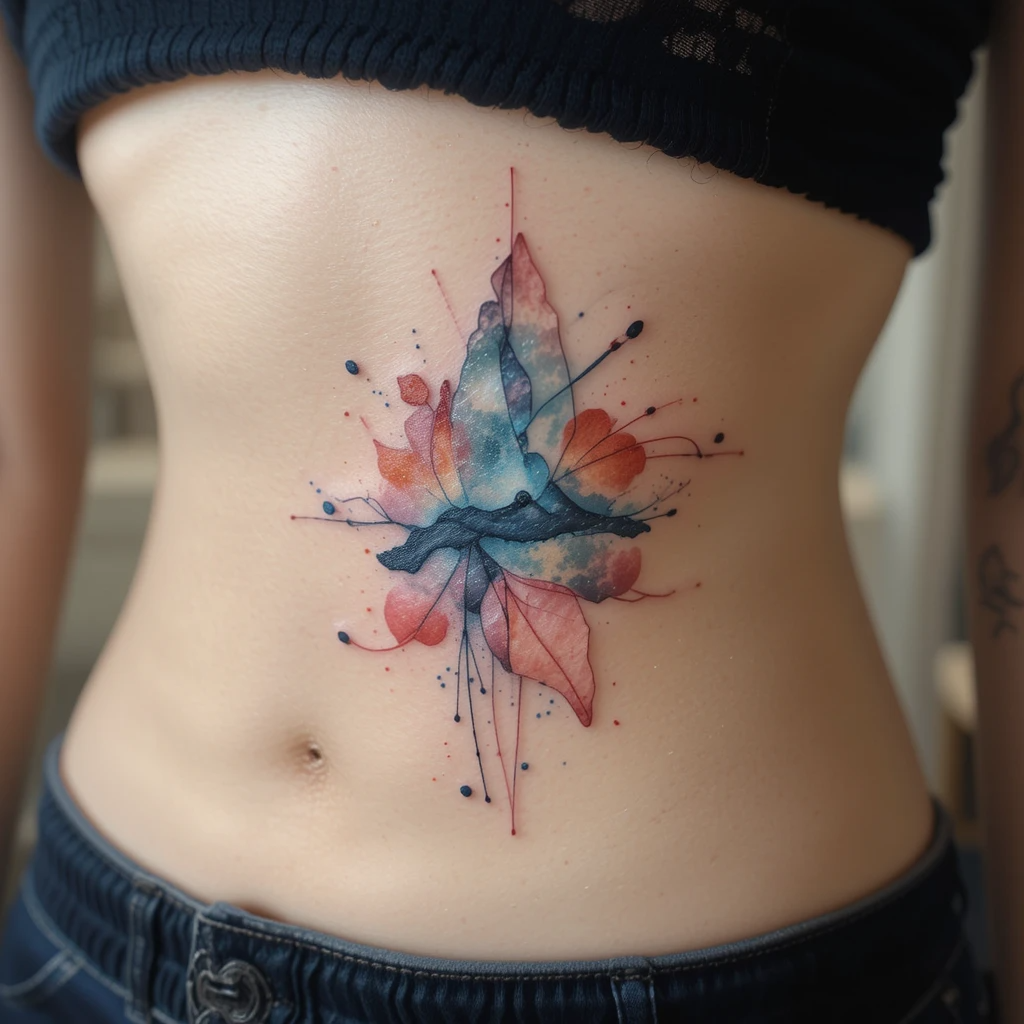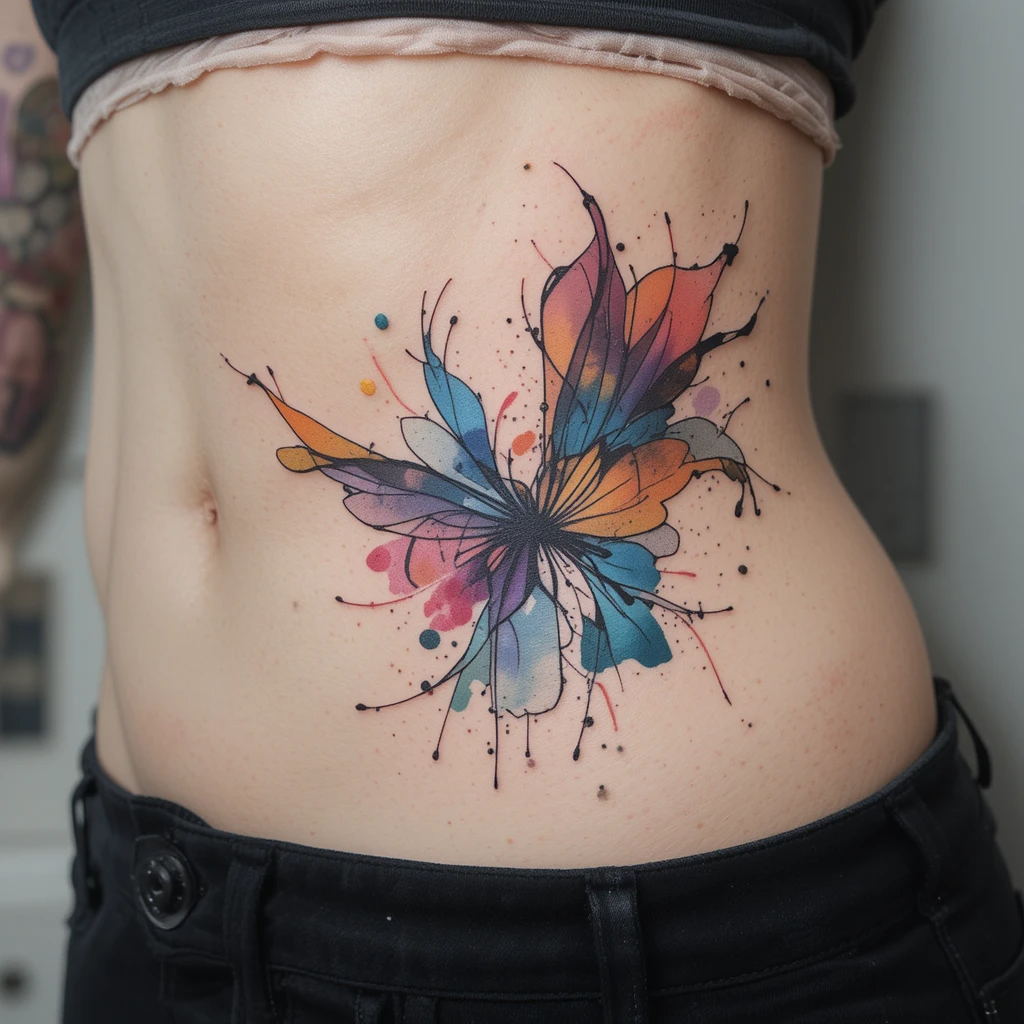In the dynamic landscape of contemporary body art, few innovations have captured the imagination and transformed artistic possibilities like the watercolor tattoo movement. These magnificent pieces merge the spontaneous fluidity of traditional watercolor painting with the precision demands of permanent skin art, creating body modifications that speak to both aesthetic revolution and technical mastery. The stunning tattoos showcased here demonstrate how visionary artists transform liquid pigment techniques into sophisticated statements of artistic freedom, emotional expression, and humanity’s eternal desire to wear beauty as personal transformation.
The Art of Liquid Expression: Understanding Watercolor Technique
Watercolor tattooing represents a dramatic departure from traditional tattooing approaches, embracing spontaneity, color interaction, and organic flow as fundamental design principles that mirror the beloved painting medium’s most cherished characteristics.
The Philosophy of Fluid Art Translation
Throughout artistic history, watercolor painting has celebrated unpredictability and organic beauty:
- Spontaneous Creation: Embracing accidents and unexpected color interactions as sources of artistic beauty
- Emotional Immediacy: Direct expression of feeling through color and form without excessive control or constraint
- Natural Movement: Working with gravity, absorption, and pigment behavior rather than fighting these natural forces
- Chromatic Harmony: Understanding color relationships and how pigments interact to create depth and emotional resonance
- Transparent Beauty: Layering translucent colors to achieve luminosity and atmospheric effects impossible with opaque media
- Organic Composition: Allowing natural flow patterns and spontaneous shapes to guide design development
When translated into tattoo form, these watercolor principles create body art that captures the medium’s essential spirit while adapting to skin’s unique properties and the permanence requirements of professional tattooing.
The Anatomy of Watercolor Tattoo Elements
Watercolor tattoos embody distinctive visual characteristics through their revolutionary technical approach:
- Fluid Color Bleeds: Organic color transitions that mirror paint spreading across wet paper
- Splatter Techniques: Controlled paint splashes and dots that suggest artistic spontaneity and creative energy
- Transparent Layering: Building color depth through overlapping washes that create luminous effects
- Organic Shapes: Forms that follow natural flow patterns rather than rigid geometric constraints
- Color Interaction: Deliberate mixing zones where different hues blend and create new chromatic relationships
- Atmospheric Effects: Soft gradients and diffused edges that suggest light, air, and dimensional space
This revolutionary visual vocabulary makes watercolor tattoos powerful expressions of artistic innovation that operate on multiple levels of aesthetic appreciation, connecting personal expression to broader movements in contemporary art.

The Technical Revolution in Watercolor Tattoo Execution
These watercolor tattoos represent a sophisticated approach to color application, demonstrating how traditional painting techniques can be transformed into stunning body art through masterful adaptation and technical innovation.
Advanced Color Application Techniques
The technical execution visible in these pieces showcases several revolutionary tattoo methods essential for watercolor effects:
- Gradient Mastery: Creating seamless color transitions that mirror watercolor’s natural blending properties
- Splatter Control: Achieving spontaneous-looking paint splatters through carefully controlled tattooing techniques
- Layering Precision: Building transparent color effects through multiple application passes and strategic opacity variation
- Color Saturation: Balancing vibrant intensity with subtle transparency to achieve authentic watercolor luminosity
- Edge Work: Creating both sharp definition and soft diffusion within the same design composition
- Compositional Flow: Ensuring overall design movement follows organic principles while maintaining visual cohesion
This level of technical execution requires exceptional skill in both color theory and advanced tattoo application, representing the cutting edge of contemporary body art innovation.
The Science of Watercolor Effect Translation
These watercolor designs embody important principles of translating painting techniques into permanent skin art:
- Pigment Behavior: Understanding how tattoo inks interact differently than watercolor paints on paper
- Skin Canvas: Adapting painting techniques to work with skin texture, healing properties, and long-term color retention
- Permanence Planning: Creating watercolor effects that will maintain beauty and clarity throughout natural aging processes
- Color Stability: Selecting pigment combinations that will age gracefully while preserving chromatic relationships
- Technical Adaptation: Modifying traditional painting methods to work within tattooing’s technical constraints
- Artistic Integrity: Maintaining watercolor’s essential aesthetic spirit while embracing tattoo medium’s unique properties
This approach reflects deep understanding of both artistic tradition and contemporary technical possibilities, creating tattoos that honor painting heritage while pushing body art boundaries.
Placement Strategies and Anatomical Considerations
The strategic placement of these watercolor tattoos demonstrates sophisticated understanding of how fluid art interacts with body anatomy, movement, and the organic nature of watercolor aesthetics.
The Torso as Artistic Canvas
The torso placement provides unique opportunities for watercolor display:
- Expansive Surface: Large canvas area allowing for full watercolor composition development and artistic breathing room
- Natural Curves: Body contours that enhance organic flow patterns and complement watercolor’s fluid nature
- Intimate Artistry: Placement creating special moments of artistic revelation and personal beauty sharing
- Movement Integration: Watercolor imagery that flows naturally with breathing, posture changes, and daily activities
- Compositional Freedom: Space allowing for complex color interactions and sophisticated artistic development
- Aesthetic Impact: Central body placement that maximizes watercolor art’s visual and emotional influence
This placement choice reflects deep consideration of both aesthetic impact and how watercolor art functions as personal artistic statement.
Ribcage Positioning for Fluid Dynamics
The ribcage offers different advantages for watercolor imagery:
- Anatomical Flow: Natural body lines that enhance watercolor’s organic movement and directional energy
- Vertical Canvas: Orientation allowing for dramatic color flows and gravitational paint effects
- Personal Significance: Placement near the heart suggesting emotional connection and intimate artistic meaning
- Curved Surface: Three-dimensional canvas that adds depth and visual interest to watercolor compositions
- Protected Location: Positioning that preserves delicate watercolor effects from excessive sun exposure and wear
- Artistic Intimacy: Placement creating opportunities for meaningful artistic sharing and aesthetic appreciation
This positioning demonstrates understanding of how placement influences both visual impact and long-term preservation of delicate watercolor effects.
Chest Placement for Central Focus
The chest area provides distinctive watercolor presentation opportunities:
- Central Statement: Prime body real estate that positions watercolor art as primary aesthetic statement
- Symmetrical Balance: Placement allowing for balanced composition and harmonious visual weight distribution
- Visibility Control: Location offering both public artistic display and private aesthetic enjoyment options
- Anatomical Enhancement: Working with natural body structure to complement and enhance watercolor flow
- Emotional Connection: Chest placement suggesting deep personal significance and heartfelt artistic commitment
- Artistic Prominence: Central positioning that ensures watercolor art receives appropriate aesthetic attention and appreciation
This central placement reflects commitment to watercolor art as primary aesthetic identity and personal artistic statement.
Color Theory and Chromatic Harmony in Watercolor Tattoos
The sophisticated color relationships visible in these watercolor tattoos demonstrate advanced understanding of chromatic theory and how color interactions create emotional and aesthetic impact.
The Psychology of Color in Watercolor Art
Watercolor tattoos often reflect psychological connections to color symbolism and emotional expression:
- Blue Depths: Cool colors suggesting tranquility, introspection, and emotional depth
- Warm Energy: Reds, oranges, and yellows conveying passion, vitality, and life force
- Purple Mystery: Complex hues suggesting creativity, spirituality, and artistic sophistication
- Color Interaction: How adjacent colors influence perception and create emotional resonance
- Chromatic Balance: Achieving harmony between warm and cool colors for visual and emotional equilibrium
- Personal Color Connection: Individual relationships with specific hues and their personal significance
These psychological connections make watercolor tattoos particularly meaningful for individuals seeking to express emotional complexity and personal aesthetic sensitivity.
Technical Color Mastery in Watercolor Execution
The human attraction to watercolor imagery reveals important aesthetic truths:
- Color Purity: Understanding how to maintain clean, vibrant colors while creating natural mixing effects
- Transparent Layering: Building color depth without losing luminosity or creating muddy combinations
- Chromatic Transition: Creating smooth color gradients that mirror watercolor painting’s natural flow
- Saturation Control: Balancing intense colors with subtle tones for authentic watercolor appearance
- Color Temperature: Managing warm and cool color relationships for emotional and visual impact
- Harmonic Composition: Ensuring color choices work together to create unified aesthetic experience
Watercolor tattoos serve as permanent celebrations of color mastery and chromatic beauty that enhance daily aesthetic experience.

Cultural Context and Artistic Movement Integration
Watercolor tattoos connect to broader movements in contemporary art, reflecting cultural shifts toward personal expression, artistic innovation, and the democratization of fine art techniques.
The Contemporary Art Connection
Watercolor tattooing emerges from significant cultural and artistic movements:
- Street Art Revolution: Urban art movements bringing fine art techniques to public and personal spaces
- Digital Art Influence: Technology expanding color possibilities and inspiring new approaches to traditional media
- Craft Renaissance: Contemporary renewal of interest in traditional artistic techniques and handmade beauty
- Personal Expression: Cultural emphasis on individual aesthetic identity and artistic self-representation
- Art Democratization: Movement making fine art techniques accessible beyond traditional gallery spaces
- Contemporary Aesthetics: Modern design sensibilities emphasizing color, fluidity, and organic beauty
This cultural context provides watercolor tattoos with relevance to broader artistic and social movements while maintaining connection to traditional painting heritage.
Global Watercolor Traditions and Cultural Adaptation
Watercolor techniques manifest differently across various cultural and artistic traditions:
- European Watercolor Heritage: Classical European painting traditions emphasizing technique mastery and color theory
- Asian Ink Wash Influence: Eastern artistic traditions of fluid ink application and spontaneous expression
- Contemporary Global Art: International movements exploring color, abstraction, and personal expression
- Digital Age Aesthetics: Modern color palettes and effects inspired by digital art and contemporary design
- Cultural Color Symbolism: How different cultures interpret and use color for emotional and spiritual expression
- Artistic Fusion: Contemporary synthesis of diverse watercolor traditions and cultural approaches
Understanding these global influences helps create tattoos that reflect authentic connection to specific artistic and cultural contexts while honoring watercolor’s universal appeal.

The Emotional Landscape of Watercolor Expression
Choosing watercolor tattoos reflects deep psychological connections to artistic expression, emotional fluidity, and the human need for beauty and creative connection in daily life.
The Language of Color: Emotional Psychology
Watercolor tattoos often reflect psychological patterns related to emotional expression and aesthetic identity:
- Emotional Fluidity: Embracing change, growth, and the natural evolution of feelings and experiences
- Creative Identity: Expressing connection to artistic creativity and aesthetic sensitivity
- Beauty Appreciation: Demonstrating commitment to surrounding oneself with visual beauty and artistic excellence
- Spontaneity Acceptance: Embracing life’s unpredictable elements and finding beauty in unexpected outcomes
- Color Sensitivity: Heightened awareness of chromatic beauty and its emotional and psychological effects
- Artistic Connection: Maintaining relationship with creative expression and artistic appreciation
These psychological connections make watercolor tattoos particularly meaningful for individuals processing creative identity and aesthetic expression needs.
The Artistic Mindset: Living with Creative Expression
The human attraction to watercolor imagery reveals important creative truths:
- Beauty Priority: Recognition that aesthetic experience enhances quality of life and emotional well-being
- Creative Expression: Understanding that artistic identity is essential component of personal authenticity
- Color Sensitivity: Developing heightened awareness of chromatic beauty and its psychological effects
- Spontaneity Appreciation: Finding beauty in unexpected outcomes and organic development
- Artistic Connection: Maintaining active relationship with creative expression and aesthetic appreciation
- Emotional Fluidity: Embracing change and growth as natural parts of human experience
Watercolor tattoos serve as permanent reminders of these creative principles and their relevance to living an aesthetically rich and emotionally fulfilling life.
Technical Maintenance and Long-term Color Preservation
The delicate nature of watercolor effects requires specialized care and understanding to maintain beauty and chromatic integrity throughout the tattoo’s lifetime.
Preservation Strategies for Watercolor Excellence
Several factors influence the long-term success of watercolor tattoos:
- Sun Protection: Critical importance of UV protection for maintaining color vibrancy and preventing fading
- Skin Care: Proper moisturizing and care to preserve color saturation and prevent premature aging
- Touch-up Planning: Understanding when and how to refresh watercolor effects for optimal appearance
- Artist Selection: Choosing specialists who understand watercolor longevity and color stability
- Color Choice: Selecting pigment combinations that age gracefully while maintaining chromatic relationships
- Lifestyle Considerations: How daily activities and habits affect watercolor tattoo preservation
Understanding these maintenance factors helps ensure watercolor tattoos continue providing aesthetic value and artistic beauty throughout their lifetime.

The Science of Color Aging in Watercolor Tattoos
Watercolor tattoo longevity involves several technical considerations:
- Pigment Stability: How different ink colors fade and change over time in skin
- Color Interaction: How adjacent colors age differently and affect overall composition appearance
- Skin Changes: Natural aging processes and their impact on tattoo appearance and color retention
- Environmental Factors: Sun exposure, climate, and lifestyle impacts on watercolor preservation
- Touch-up Timing: Optimal scheduling for color refreshing and artistic maintenance
- Artist Expertise: Importance of specialists who understand watercolor aging and preservation strategies
Viewing watercolor tattoos as long-term artistic investments helps ensure decisions that provide lasting aesthetic value and chromatic beauty.
Choosing the Right Artist for Watercolor Excellence
The sophisticated color work and technical demands of watercolor tattoos require specialized expertise in color theory, fluid effects, and advanced tattoo application techniques.
Technical Requirements for Watercolor Mastery
Artists specializing in watercolor imagery must demonstrate:
- Color Theory Expertise: Deep understanding of chromatic relationships and color interaction principles
- Watercolor Knowledge: Familiarity with traditional painting techniques and their tattoo adaptations
- Technical Excellence: Advanced skills in gradient work, color blending, and complex shading
- Effect Recreation: Ability to authentically recreate watercolor painting effects in tattoo medium
- Composition Skills: Understanding of how to create balanced, flowing designs that honor watercolor aesthetics
- Portfolio Evidence: Previous work demonstrating competence in watercolor effects and color mastery
The artistic nature of watercolor tattoos demands specialists who approach color work with both technical excellence and creative sensitivity.
Artistic Vision and Creative Collaboration
Beyond technical competence, the right watercolor artist should demonstrate:
- Creative Sensitivity: Genuine appreciation for artistic expression and aesthetic innovation
- Color Intuition: Natural understanding of chromatic beauty and emotional color impact
- Collaborative Spirit: Willingness to work with clients to achieve personalized artistic results
- Quality Standards: Commitment to excellence befitting fine art translation and aesthetic permanence
- Innovative Approach: Openness to pushing boundaries and exploring new watercolor techniques
- Educational Willingness: Ability to guide clients through color choices and design development
The relationship between artist and client becomes particularly important for achieving authentic watercolor effects and personal aesthetic satisfaction.
Regional Styles and International Watercolor Movements
Watercolor tattoo techniques vary across different artistic regions, reflecting local art traditions, color preferences, and cultural approaches to artistic expression.
American Watercolor Innovation
American tattoo culture brings distinctive elements to watercolor development:
- Bold Color Choices: American preference for vibrant, high-contrast color combinations
- Technical Innovation: Pioneering new methods for achieving watercolor effects in tattoo medium
- Individual Expression: Emphasis on personal artistic identity and unique aesthetic statements
- Contemporary Influence: Integration with modern art movements and digital age aesthetics
- Artistic Freedom: Cultural support for experimental techniques and boundary-pushing approaches
- Commercial Excellence: Professional standards and business practices supporting artistic innovation
These American influences create dynamic versions of watercolor techniques that emphasize innovation and individual expression.
International Watercolor Traditions
Global artistic traditions contribute diverse elements to watercolor tattooing:
- European Classical Influence: Traditional watercolor painting heritage and technical mastery
- Asian Fluid Traditions: Eastern approaches to ink flow and spontaneous artistic expression
- Contemporary Global Art: International movements exploring color, abstraction, and personal expression
- Cultural Color Symbolism: Regional approaches to color meaning and chromatic significance
- Artistic Exchange: International sharing of techniques and creative approaches
- Cultural Synthesis: Modern fusion of diverse watercolor traditions and artistic influences
Understanding these international traditions helps create tattoos that reflect authentic connection to specific artistic and cultural contexts.
The Economics of Artistic Excellence Investment
Quality watercolor tattoos represent significant artistic and financial investments requiring careful consideration and planning for optimal results.
Pricing Factors for Watercolor Excellence
Several elements influence the cost of superior watercolor tattoos:
- Artist Specialization: Premium pricing for specialists in watercolor techniques and color mastery
- Design Complexity: Intricate color work requiring extensive artistic knowledge and technical skill
- Size and Detail: Larger watercolor pieces allowing for more color development but requiring more time
- Color Requirements: Complex chromatic work demanding premium inks and extended application time
- Studio Reputation: Established shops with proven track records in artistic and watercolor work
- Geographic Location: Regional variations in pricing and watercolor specialist availability
Understanding these cost factors helps in budgeting appropriately for work that will provide lasting artistic value and aesthetic satisfaction.
Long-term Artistic and Aesthetic Value
The investment in watercolor tattoos extends beyond initial application:
- Aesthetic Durability: How watercolor imagery maintains beauty and emotional impact throughout life changes
- Artistic Aging: Quality watercolor work maintaining chromatic relationships and visual appeal over decades
- Maintenance Investment: Periodic touch-ups and care to preserve color vibrancy and artistic integrity
- Personal Growth: How watercolor tattoos continue providing aesthetic satisfaction during personal development
- Artistic Connection: Ongoing value as connection to creative expression and aesthetic appreciation
- Legacy Consideration: Watercolor tattoos as expression of artistic sensibility that may influence family and community
Viewing watercolor tattoos as long-term artistic investments helps ensure decisions that provide lasting aesthetic value and creative satisfaction.
The Social Impact of Artistic Innovation in Contemporary Culture
Watercolor tattoos influence not only personal aesthetic identity but also broader cultural conversations about art accessibility, creative expression, and the democratization of fine art techniques.
Art Democratization Through Accessible Excellence
These tattoos contribute to important cultural developments in contemporary society:
- Art Accessibility: Making fine art techniques available beyond traditional gallery and classroom spaces
- Creative Expression: Watercolor imagery as catalyst for broader interest in artistic creativity and aesthetic appreciation
- Artistic Presence: Maintaining fine art sensibilities and imagery in everyday cultural spaces
- Beauty Standards: Using artistic excellence to elevate aesthetic expectations and creative standards
- Cultural Enrichment: Watercolor tattoos as contribution to community artistic appreciation and cultural development
- Creative Inspiration: Inspiring others to engage with artistic expression and aesthetic creativity
This democratization function extends watercolor tattoos beyond personal aesthetics to active participation in cultural artistic development.
Building Creative Community Through Artistic Expression
Watercolor tattoos create connections among individuals who share commitment to artistic appreciation and creative expression:
- Artistic Communities: Supporting networks of individuals committed to aesthetic appreciation and creative expression
- Creative Movements: Connecting with renewal movements focused on artistic practice and aesthetic development
- Artistic Patronage: Supporting artists who specialize in innovative and excellent artistic work
- Aesthetic Networks: Building relationships with individuals committed to beauty and artistic appreciation
- Creative Education: Connecting with individuals interested in artistic education and creative development
- Mentorship Relationships: Strengthening bonds through shared artistic identity and aesthetic appreciation
These community-building functions make watercolor tattoos powerful tools for creative social connection and mutual artistic support.
Conclusion: Wearing Liquid Art as Permanent Beauty
Watercolor tattoos represent one of contemporary body art’s most innovative and aesthetically significant developments. These magnificent images unite traditional painting techniques with cutting-edge tattoo artistry, creating permanently wearable art that speaks to universal human appreciation for color, beauty, and creative expression while honoring individual relationships with artistic identity and aesthetic sensitivity.
The exceptional examples showcased here demonstrate how skilled artists can transform fluid painting techniques into powerful statements of remarkable beauty and artistic sophistication. They invite us to consider our own relationships with color, creativity, artistic expression, and the role of beauty in enriching daily experience while connecting us to the vast tradition of artists who have found meaning and inspiration in chromatic exploration.
For those drawn to the revolutionary aesthetics of watercolor imagery, these tattoos offer opportunities to wear one’s commitment to artistic appreciation, creative expression, and aesthetic excellence as permanent body art. They represent not just technical achievement, but statements of artistic identity that honor both individual creativity and collective heritage rooted in humanity’s greatest painting traditions.
In the expanding universe of tattoo artistry, watercolor tattoos stand as testament to the power of combining traditional artistic techniques with contemporary innovation and personal aesthetic vision. They remind us that the most transformative body art often emerges from humanity’s deepest creative impulses, realized through artistic skill and aesthetic devotion into permanent celebrations of beauty and chromatic joy.
These tattoos carry forward the innovation of artistic tradition into contemporary life, suggesting that the creativity, beauty, and aesthetic sensitivity required for meaningful artistic expression remain relevant and necessary for flourishing in the complexities of modern existence. They represent art that doesn’t just decorate the body, but enriches the soul with daily reminders of beauty’s transformative power and the eternal human capacity for creative expression and chromatic celebration.


